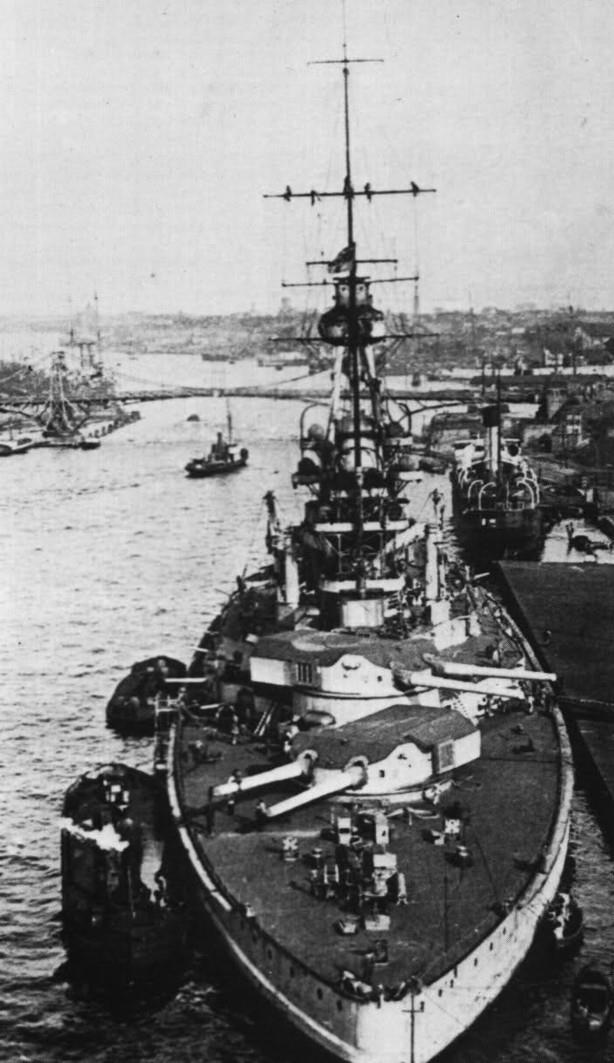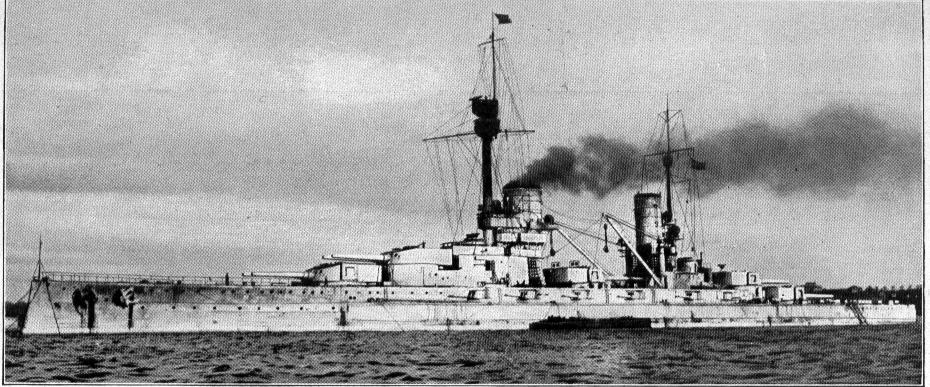KM Konig (BB-1914 (1936-rebuild))
Back to Germanic States Navy page:
Each class of German battleship evolved from the previous class as the German
Navy tried to keep pace with the innovations and increases in gunpower put to
sea by the Royal Navy. From the Nassau with their 8x11", to the Ostfrieslands
with 8x12", then the Kaiser class went to 10x12". The Konig class would finally
put to sea a much better gun than the Royal Navy had. The 13.75" was far
superior to the British 13.5". No sooner than the Konig class of four ships had
been laid down than intelligence arrived that the British had laid down five
ships to be armed with 15" guns. What would happen next?
Notwithstanding what was to come in the next round of 'mine is bigger than
yours', the Konig Class were excellent examples of what was to be known as
Super-Dreadnoughts.

Displacement: 26,200 tons normal displacement, 28,000 tons full load
Dimensions: 575 x 97 x 30 feet
Machinery: 3 shaft turbines, 44,000shp
Speed: 22 knots
Endurance: 7,500 nmi at 12 knots
Armour: 350mm (13.75") belt, 30mm (1.2") deck, 330mm/210mm/150mm turrets
Armament:
8 x 13.75" (4x2)
14 x 5.9" (14x1)
10 x 88mm AA (10x1)
Torpedoes: 6 x 500mm (6x1 underwater)
Crew: 1150 (1210 as Flagship)
The war is over and Germany is defeated. A new problem in the form of the
Bolsheviks in Russia rears its head. France and Britain try the direct approach
and try to raise the White Revolution in response, to restore the Russian
democratic system in whatever form could be constituted. This intervention is
defeated and the Bolsheviks rule supreme in Russia, the first pogroms sweep
through Russia killing millions. Because of this the Western Powers wanted to
set up buffer zones to keep the Bolshevik menace at bay. Germany was to be one
of these and was to supply the naval forces to keep the Bolshevik Navy bottled
up in the Baltic Sea.
The Bolsheviks already had three of the 12x12" armed Dreadnoughts available in
the Baltic and at least two of the advanced Borodino class battlecruisers that
could be completed in a short period of time. To counter this the Germans were
given a mix of old and new ships, which included two of the Konig class. The
other two ships of the class were sold to Argentina (see
ARA
Catamarca).

The three Kaisers, two Konig's and the Wurtemberg were the German fleets main
fleet units against the Bolshevik Fleet based in Leningrad. The other two ships
of the older Nassau class were demilitarised to training ships on completion of
the Wurtemberg. Two battlecruisers completed the Weimar Fleet. Although it was
found by 1930 that the estimates of the Bolshevik Fleet had been wrong, the
German Navy was kept as it was with no further sanctions against it. While a
rebuilding program was worked out rebuild the old capital ships that would be
required to be kept well past their 'best before' dates. The two Konig class
started their transformations in 1935 and completed them in 1937.

Displacement: 27,500 tons normal displacement, 28,000 tons full load
Dimensions: 575 x 97 x 30 feet
Machinery: 3 shaft turbines, 60,000shp
Speed: 24 knots
Endurance: 7,500 nmi at 12 knots
Armour: 350mm (13.75") belt, 130mm (5.1") deck, 330mm/210mm/150mm turrets
Armament:
8 x 13.75" (4x2)
12 x 5" (6x2)
12 x 37mm AA (6x2)
10x20mm (10x1)
Crew: 1150 (1210 as Flagship)
Konig (10/1914) Lost:
Markgraf (10/1914) Sold to Argentina (see
ARA
Catamarca).
Grosser Kurfurst (07/1914) Lost:
Kronprinz Wilhelm (11/1914) Sold to Argentina (see
ARA
Catamarca).
Original Konig class battleships with their 10x12" and centre mounted
turret.
Germany with the alterations to the Versailles treaty are allowed to keep 2
of the Konig class ships. They form part of the fleet that must be based in the
Baltic to neutralise the Soviet fleet if it becomes hostile. Both ships remain
virtually unaltered till 1934 when they are taken in for modernisation along the
lines of other navies rebuilds. 1934 marks the entry of the 5.1" DP weapon
system into the German armoury which allows them to get rid of the cluttered
5.9" / 4.1" secondary / tertiary batteries. With new propulsion systems of mixed
steam and diesel, new bow to alter the hull form, new deck armour and new
superstructure the Konigs emerged from their modernisations as much more durable
ships.
The Germans had copied the British arrangement of a Q centre turret for this
class rather than the lozenge mounted guns in the previous Kaiser class. This
also meant that when the rebuilding of these ships took place in 1934-36 the
removal of the Q turret allowed the placement of the new mixed diesel and steam
propulsion plants.

.PNG)
|
Displacement |
31,200 tons full load |
|
Length |
610 ft |
|
Breadth |
97 ft |
|
Draught |
30 ft |
|
Machinery |
steam turbines, 50,000shp
diesel engines, 35,000bhp |
|
Speed |
27 knots |
|
Armour |
13.8" side 5.1" deck 12" turrets |
|
Armament |
8 x 12" (4x2) 16 x
5.1" (8x2)
46 x 20mm (10x4 6x1) |
|
Aircraft |
nil |
|
Torpedoes |
nil |
Back to Germanic States Navy page:



